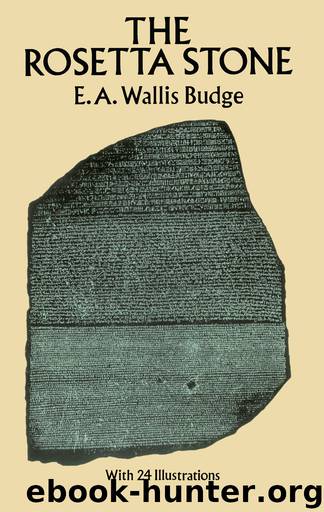The Rosetta Stone by E. A. Wallis Budge

Author:E. A. Wallis Budge
Language: eng
Format: epub
Publisher: Dover Publications
Published: 2013-04-14T04:00:00+00:00
V.—THE INTRODUCTION OF CHRISTIANITY INTO EGYPT, AND THE INVENTION OF THE COPTIC ALPHABET
Many of the principal Greek officials who died in Egypt were mummified, and their coffins, sarcophagi, funerary coffers and stelae, and even their mummy bandages, were inscribed in Greek. But during the whole of the period of Roman rule in EGYPT, the natives continued to mummify their dead, and the inscriptions upon their mummies were written sometimes in Demotic, and sometimes in hieroglyphs, to many of which new phonetic values had been given. Many of these inscriptions are untranslatable. The event which brought the use of hieroglyphic writing to an end for funerary purposes was the adoption of CHRISTIANITY by the EGYPTIANS as the result of the alleged preaching of ST. MARK at ALEXANDRIA in the second half of the Ist century A.D. The EGYPTIAN CHRISTIANS loathed and abominated the religion and gods of their pagan ancestors, and wholly refused to employ either the hieroglyphic or demotic writing in their funerary inscriptions. Some time during the 1st century B.C. or the 1st century A.D. some persons thought they they would like to write the Egyptian language in Greek letters, probably because they found it very difficult to learn to read and write the demotic script. But, when they came to do so, they found that there were certain sounds in Egyptian for which the Greek alphabet contained no letters. Thereupon they added to the Greek alphabet seven letters,4 which were formed of modifications of the hieratic and demotic symbols of certain hieroglyphs, and by degrees this composite alphabet came into use in the country. Whether the EGYPTIAN CHRISTIANS ever tried to write the translations of the Books of the Old and New Testaments in Demotic cannot be said, but it is improbable, for their one aim was to free themselves from contact with everything that appertained to the religion of their pagan ancestors, whom they regarded as besotted idolators.
The name usually given to the Egyptian Christians, “Ḳubbî” or “Gubbî,” i.e. “man of Egypt,” “Ḳubt,” or “Gubt,” i.e. EGYPT, is thought to be derived from the Greek name of EGYPT, Αἴγυπτος, which, in turn, seems to be derived from ḤEKAPTAḤ, a name of MEMPHIS. Another view is that the original Egyptian word for Egypt was Ageb, , and that it meant “the land of the flood,” i.e. inundation, , which was poured out from the great World-Ocean by the Flood-god AGEB, . Others again would derive “Ḳubtî” or “Gubtî” from the name of the town of QEBTI, , i.e. COPTOS in Upper Egypt, whither the Egyptian Christians fled in large numbers during the Roman persecutions.
Be this as it may, the Christian Egyptians are now, and have for centuries been, known as “COPTS,” and the Egyptian language written in Greek letters is called “COPTIC.” How important this form of the Egyptian language was for the early decipherers of the Egyptian hieroglyphic inscriptions will be seen later on. In the course of time the use of Coptic superseded that of demotic
Download
This site does not store any files on its server. We only index and link to content provided by other sites. Please contact the content providers to delete copyright contents if any and email us, we'll remove relevant links or contents immediately.
| Africa | Americas |
| Arctic & Antarctica | Asia |
| Australia & Oceania | Europe |
| Middle East | Russia |
| United States | World |
| Ancient Civilizations | Military |
| Historical Study & Educational Resources |
The Daily Stoic by Holiday Ryan & Hanselman Stephen(3264)
The Fate of Rome: Climate, Disease, and the End of an Empire (The Princeton History of the Ancient World) by Kyle Harper(3030)
People of the Earth: An Introduction to World Prehistory by Dr. Brian Fagan & Nadia Durrani(2711)
Ancient Worlds by Michael Scott(2648)
Babylon's Ark by Lawrence Anthony(2648)
The Daily Stoic by Ryan Holiday & Stephen Hanselman(2523)
Foreign Devils on the Silk Road: The Search for the Lost Treasures of Central Asia by Peter Hopkirk(2442)
India's Ancient Past by R.S. Sharma(2432)
MOSES THE EGYPTIAN by Jan Assmann(2394)
The Complete Dead Sea Scrolls in English (7th Edition) (Penguin Classics) by Geza Vermes(2258)
Lost Technologies of Ancient Egypt by Christopher Dunn(2208)
The Earth Chronicles Handbook by Zecharia Sitchin(2203)
24 Hours in Ancient Rome by Philip Matyszak(2065)
Alexander the Great by Philip Freeman(2044)
Aztec by Gary Jennings(1992)
The Nine Waves of Creation by Carl Johan Calleman(1898)
Curse Tablets and Binding Spells from the Ancient World by Gager John G.;(1851)
Before Atlantis by Frank Joseph(1832)
Earthmare: The Lost Book of Wars by Cergat(1806)
